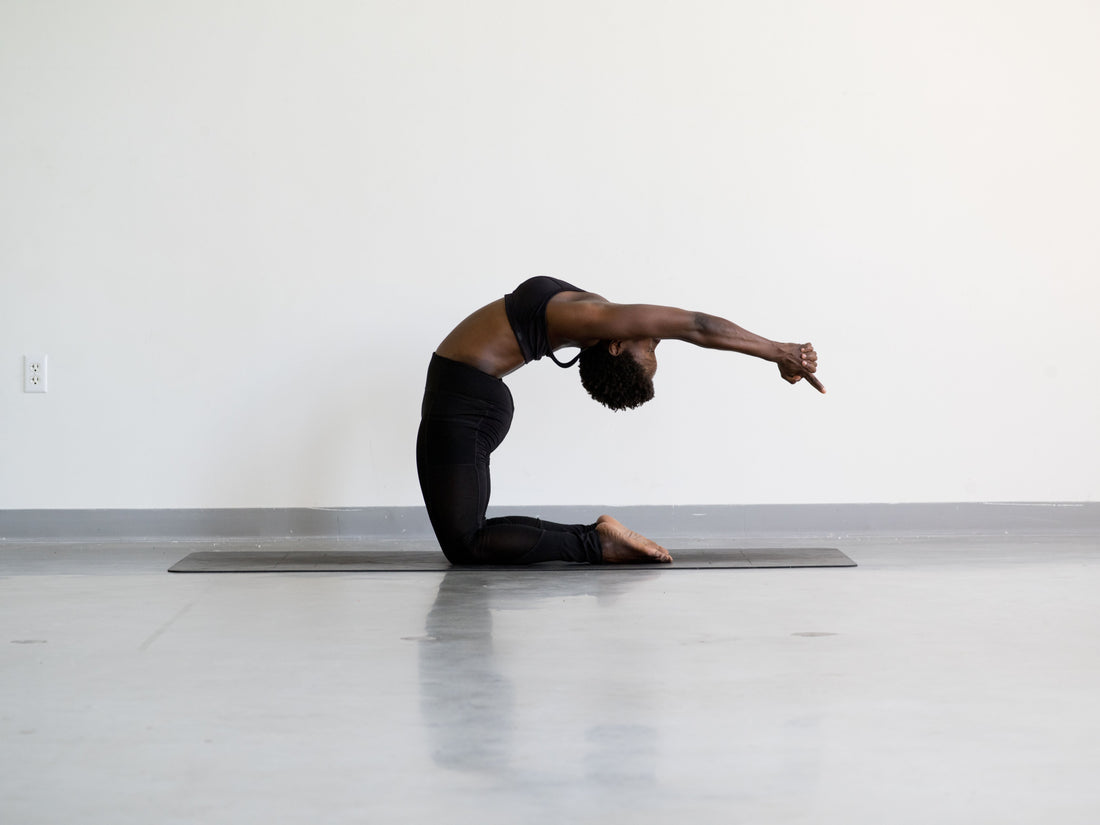
This week's pose is camel pose in Sanskrit known as Ustrasana. It has been one I have a love-hate relationship with; either it feels really good or really horrible. When I was heavy in my Bikram practice it would tell me if I needed to cleanse my body or my heart. Can we say, "Hello, nausea and dizziness!"
Ustrasana is a deep back bend and an amazing heart opener.
Instructions
- Begin by kneeling in an upright position keeping your knees hip-distance apart. Rotate your thighs inward and press your shins and the tops of your feet into the floor. Do not squeeze your buttocks.
- Rest your hands on the back of your pelvis, with your fingers pointing to the floor. Lengthen your tailbone down toward the floor and widen the back of your pelvis.
- Lean back, with your chin slightly tucked toward your chest. Beginners can stay here, keeping their hands on their back pelvis.
- If you are comfortable here, you can take the pose even deeper. Reach back and hold onto each heel. Your palms should rest on your heels with your fingers pointing toward your toes and your thumbs holding the outside of each foot.
- Keep your thighs perpendicular to the floor, with your hips directly over your knees. If it is difficult to grasp your heels without feeling compression in your low back, tuck your toes to elevate your heels. You can also rest your hands on yoga blocks placed to the outside of each foot.
- Lift up through your pelvis, keeping your lower spine long. Turn your arms outward without squeezing your shoulder blades. Keep your head in a neutral position, or allow it to drop back without straining or crunching your neck.
- Hold for 30-60 seconds. To release, bring your hands back to your front hips. Inhale, lead with your heart, and lift your torso by pushing your hips down toward the floor. Your head should come up last. Rest in Child’s Pose (Balasana) or Corpse Pose (Savasana).

Modifications & Variations
Ustrasana can be an energizing way to gain spinal flexibility. However, it’s important to learn how to do it correctly to avoid injury and strain. Remember never to force your body into the pose. Practice a modified version until you have gained the amount of flexibility and strength you need to safely go deeper. Try these simple changes to find a variation that works for you:
If it is difficult for you to touch your hands to your feet, tuck your toes to elevate your heels.
If it is still difficult to reach your feet, place your hands on yoga blocks positioned outside of each foot.
To deepen the pose, squeeze a block between your thighs.
For an even greater challenge, press your thighs, calves, and inner feet together throughout the pose.
For a greater opening in the chest, shoulders, and arms, cross your forearms and take hold of the opposite ankles.
Tips
When practiced correctly, Ustrasana can benefit the whole body. Keep the following information in mind when practicing this pose:
When practicing backbends, it is crucial to create length between your vertebrae, being careful not to collapse or crunch into the pose. Keep your pelvis stable as you lift and lengthen your sternum toward the sky.
Take the pose slowly, only going as deep as your body will allow without pain.
Gently draw your tailbone forward while pressing the front of your thighs back. This counter-action will stabilize your pelvis as you lift and lengthen your spine, instead of compressing your spine when you lean back.
To learn the alignment of your thighs, hips, and pubic bone, practice the pose while facing a wall. Kneel with your thighs touching the wall and press your pubic bone toward the wall. As you come into the backbend, lean back only as far as you can while keeping your thighs pressing against the wall. Do not let your thighs shift away from the wall just so you can grab your heels — it is more important to keep your hips over your knees than it is to touch your heels.
Be careful not to bring your head so far back that you strain your neck. Keep your neck extended and comfortable throughout the pose.
Reach Back & Open Up
Ustrasana can be an emotionally moving and energizing yoga posture. It is vital to listen to your body throughout the pose. If your breath becomes short and strained, ease up a bit. Keep your thoughts calm and steady by returning your awareness to your breath and the present moment. Like a camel, Ustrasana can take you on a journey to new and foreign parts of yourself. Take the path slowly, stay in the moment, and allow these new parts of yourself to open wide.
Benefits of Camel Pose:
- Reduces fat on thighs
- Opens up the hips, stretching deep hip flexors
- Stretches and strengthens the shoulders and back
- Expands the abdominal region, improving digestion and elimination
- Improves posture
- Opens the chest, improving respiration
- Loosens up the vertebrae
- Relieves lower back pain
- Helps to heal and balance the chakras
- Strengthens thighs and arms
- Improves flexibility, especially in the spine
- Stimulates endocrine glands
- Releases tension in the ovaries
- Stretches the ankles, thighs, groin, abdomen, chest, and throat
- Cures constipation
- Tones organs of the abdomen, pelvis, and neck
- Complements overall health and well-being
Source:


